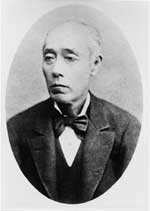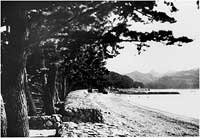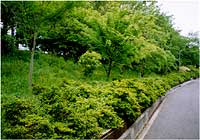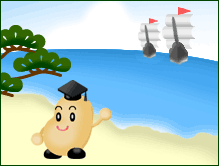 Yamasa Soy Sauce — Recipient of the “Best Soy Sauce” Honor
Yamasa Soy Sauce — Recipient of the “Best Soy Sauce” Honor



After the original Gihei Hamaguchi and following the 2nd generation Kyoryo, 3rd generation Norihiro, 4th generation Yasuroku, 5th generation Kanpo, and 6th generation Yasuhira, the grandson of the 5th generation Kanpo, Goryo, was named as the 7th Gihei Hamaguchi in 1853, nearly two centuries after the company was founded. Goryo was born in 1820 and inherited the family estate in 1853, protecting the family business amid the social unrest surrounding the end of the Tokugawa shogunate government. On top of his activities as a businessman in the capacity of the 7th generation Yamasa Soy Sauce leader, he also poured his heart and soul into selfless social welfare enterprises and political activities, leaving a big mark on the development of modern Japan.
![]()


Construction of a Breakwater to Protect against Tsunamis
During the Great Nankai Earthquake that struck twice, spanning over two days on November 4th and 5th, 1854, Goryo happened to be back in Hiromura, Kishu (modern-day Hiragawa-cho) and predicted that a major tsunami would come based on the way the seawater retreated along with rapidly receding well waters, as well as other factors. It is said that in order to evacuate the village, Goryo set fire to the harvested rice sheafs (the “inamura”) stacked in his own rice field to alert villagers of the emergency, saving the lives of the village people. Impressed by this act in which Goryo took no regard for his own safety or property, Meiji-era literary figure Lafcadio Hearn (also known as Koizumi Yakumo in Japan) introduced Goryo as “a living God” in his collection of short stories called “Gleanings in Buddha Fields”. Later, the story, “The Fire of Inamura”, written by elementary school teacher Tsunezo Nakai on the basis of Hearn’s account was adopted for use as a reading book for elementary school Japanese language classes.
「Click here for more information on “The Fire of Inamura”
![]()

The Breakwater that Remains Standing Today

Goryo’s activities were not just limited to saving people’s lives. He prevented the abandonment of the village by constructing relief housing, gathering agricultural and fishing equipment, as well as other activities, for the sake of the villagers of Hiromura that had suffered the devastating damage of a tsunami. Also, to prevent damage from future tsunamis, he proceeded with the construction of a large breakwater over the course of four years beginning in 1855 at the cost of 94 silver “kan” (roughly 3.5 kilograms). The 600-meter long, 5-meter high breakwater with pine wood on the seaside and Japanese wax tree on the land side decorates the landscape even today. The breakwater has been designated as a historical site.
![]()


Goryo — with ties to western medicine physician Gonsai Miyake who was practicing in Choshi at the end of the Tokugawa shogunate — had an interest in the west and opened his “Keikojo” (or “Practice Hall”) in 1852. The Keikojo, which explored the strengths of western civilization and served to educate and train youths, changed its name to Taikyu Co., Taikyu Academy, and Taikyu Junior High School, and now boasts a long history as present-day Wakayama Prefectural Taikyu High School.
Then, when a vaccination institute in Edo (Otamagaike) caught fire and burnt down, Goryo donated 300 ryo (a currency of the time) to rebuild it. According to the Goryo Hamaguchi Chronicle, he donated an additional 400 ryo for the purchase of books and equipment. The vaccination institute was later named the Insititute of Western Medicine and became the sole western medicine research center in Edo. (It would become the foundation for the modern-day Tokyo University Medical School)
Goryo was a figure who spared himself no pains in order to contribute to society and the advancement of personnel education and academics.
![]()

Born at the end of the Tokugawa shogunate, Goryo who had devoted himself to the advancement of Japan, was invited into the political world of the age owing to his excellent insights and the magnitude of his generosity as a human being, along with his work as a businessman in the role of the 7th generation Gihei Yamaguchi. After serving as a kanjo-bugyo (a public official) of the Wakayama domain and as the chairman of the first Wakayama Prefectural Assembly, he was invited to the Central Government where he became the first Minister of Post and Communication and worked on the creation of the modern postal system. Goryo also had a wide range of ties with intellectuals including Sakuma Shozan, Kikuchi Kaiso, Fukuda Heishiro, Katsu Kaishu, and Fukuzawa Yukichi. After Goryo’s death, Katsu Kaishu contributed an epitaph on his monument.
![]()

It was under Goryo’s tutelage that Yamasa Soy Sauce was recognized by the shogunate government for having particularly superior quality soy sauce and received the honor of “Best Soy Sauce” in 1864.
With the coming age of western cuisine to Japan, the 8th generation Gihei Hamaguchi (Gosho) created the domestically-produced Sauce No.1, Mikado Sauce, which was an achievement he inherited from Goryo’s vision of constantly looking overseas.


Goryo was active in an age of massive upheaval between the end of the Tokugawa shogunate and the Meiji period. When Commodore Perry came to Uraga by ship and pressed the Tokugawa shogunate to open Japanese ports to foreign trade, he proclaimed that “Looking at the state of the world by and large, all have opened their doors and there is not a country which does not interact with the outside.” It remains on record that, at a later date, Goryo met with senior councillor Ogasawara Ikinokami who heard Perry’s opinion. He also had strong and close ties with intellectuals of the day and is touted as a “knowledgeable person” in a handwritten letter by Fukuzawa Yukichi.CC
![]()
![]()




After the original Gihei Hamaguchi and following the 2nd generation Kyoryo, 3rd generation Norihiro, 4th generation Yasuroku, 5th generation Kanpo, and 6th generation Yasuhira, the grandson of the 5th generation Kanpo, Goryo, was named as the 7th Gihei Hamaguchi in 1853, nearly two centuries after the company was founded. Goryo was born in 1820 and inherited the family estate in 1853, protecting the family business amid the social unrest surrounding the end of the Tokugawa shogunate government. On top of his activities as a businessman in the capacity of the 7th generation Yamasa Soy Sauce leader, he also poured his heart and soul into selfless social welfare enterprises and political activities, leaving a big mark on the development of modern Japan.
![]()


Construction of a Breakwater to Protect against Tsunamis
During the Great Nankai Earthquake that struck twice, spanning over two days on November 4th and 5th, 1854, Goryo happened to be back in Hiromura, Kishu (modern-day Hiragawa-cho) and predicted that a major tsunami would come based on the way the seawater retreated along with rapidly receding well waters, as well as other factors. It is said that in order to evacuate the village, Goryo set fire to the harvested rice sheafs (the “inamura”) stacked in his own rice field to alert villagers of the emergency, saving the lives of the village people. Impressed by this act in which Goryo took no regard for his own safety or property, Meiji-era literary figure Lafcadio Hearn (also known as Koizumi Yakumo in Japan) introduced Goryo as “a living God” in his collection of short stories called “Gleanings in Buddha Fields”. Later, the story, “The Fire of Inamura”, written by elementary school teacher Tsunezo Nakai on the basis of Hearn’s account was adopted for use as a reading book for elementary school Japanese language classes.
「Click here for more information on “The Fire of Inamura”
![]()


The Breakwater that Remains Standing Today
Goryo’s activities were not just limited to saving people’s lives. He prevented the abandonment of the village by constructing relief housing, gathering agricultural and fishing equipment, as well as other activities, for the sake of the villagers of Hiromura that had suffered the devastating damage of a tsunami. Also, to prevent damage from future tsunamis, he proceeded with the construction of a large breakwater over the course of four years beginning in 1855 at the cost of 94 silver “kan” (roughly 3.5 kilograms). The 600-meter long, 5-meter high breakwater with pine wood on the seaside and Japanese wax tree on the land side decorates the landscape even today. The breakwater has been designated as a historical site.
![]()


Goryo — with ties to western medicine physician Gonsai Miyake who was practicing in Choshi at the end of the Tokugawa shogunate — had an interest in the west and opened his “Keikojo” (or “Practice Hall”) in 1852. The Keikojo, which explored the strengths of western civilization and served to educate and train youths, changed its name to Taikyu Co., Taikyu Academy, and Taikyu Junior High School, and now boasts a long history as present-day Wakayama Prefectural Taikyu High School.
Then, when a vaccination institute in Edo (Otamagaike) caught fire and burnt down, Goryo donated 300 ryo (a currency of the time) to rebuild it. According to the Goryo Hamaguchi Chronicle, he donated an additional 400 ryo for the purchase of books and equipment. The vaccination institute was later named the Insititute of Western Medicine and became the sole western medicine research center in Edo. (It would become the foundation for the modern-day Tokyo University Medical School)
Goryo was a figure who spared himself no pains in order to contribute to society and the advancement of personnel education and academics.
![]()

Born at the end of the Tokugawa shogunate, Goryo who had devoted himself to the advancement of Japan, was invited into the political world of the age owing to his excellent insights and the magnitude of his generosity as a human being, along with his work as a businessman in the role of the 7th generation Gihei Yamaguchi. After serving as a kanjo-bugyo (a public official) of the Wakayama domain and as the chairman of the first Wakayama Prefectural Assembly, he was invited to the Central Government where he became the first Minister of Post and Communication and worked on the creation of the modern postal system. Goryo also had a wide range of ties with intellectuals including Sakuma Shozan, Kikuchi Kaiso, Fukuda Heishiro, Katsu Kaishu, and Fukuzawa Yukichi. After Goryo’s death, Katsu Kaishu contributed an epitaph on his monument.
![]()

It was under Goryo’s tutelage that Yamasa Soy Sauce was recognized by the shogunate government for having particularly superior quality soy sauce and received the honor of “Best Soy Sauce” in 1864.
With the coming age of western cuisine to Japan, the 8th generation Gihei Hamaguchi (Gosho) created the domestically-produced Sauce No.1, Mikado Sauce, which was an achievement he inherited from Goryo’s vision of constantly looking overseas.


Goryo was active in an age of massive upheaval between the end of the Tokugawa shogunate and the Meiji period. When Commodore Perry came to Uraga by ship and pressed the Tokugawa shogunate to open Japanese ports to foreign trade, he proclaimed that “Looking at the state of the world by and large, all have opened their doors and there is not a country which does not interact with the outside.” It remains on record that, at a later date, Goryo met with senior councillor Ogasawara Ikinokami who heard Perry’s opinion. He also had strong and close ties with intellectuals of the day and is touted as a “knowledgeable person” in a handwritten letter by Fukuzawa Yukichi.
![]()






 Go to top Yamasa History
Go to top Yamasa History